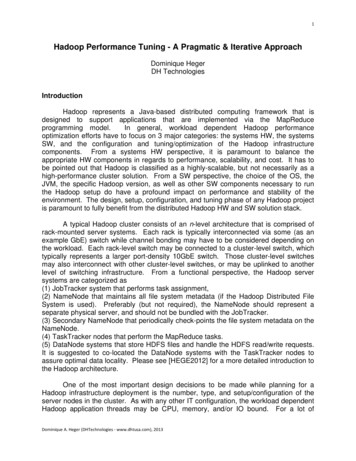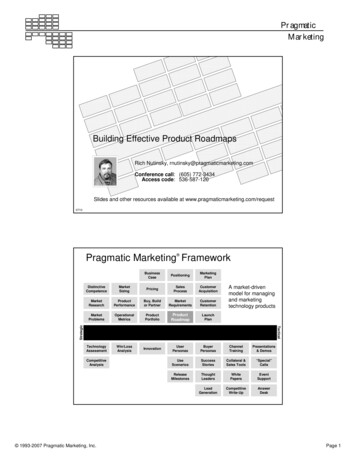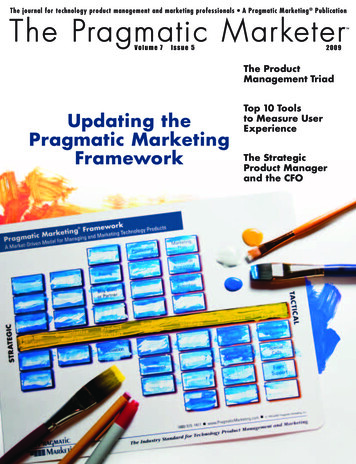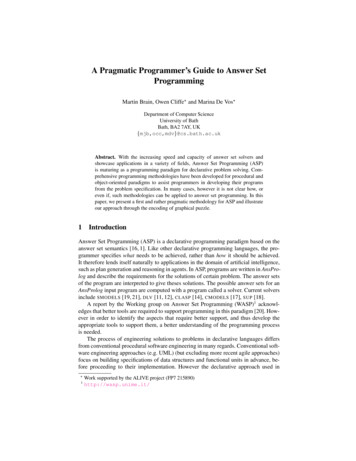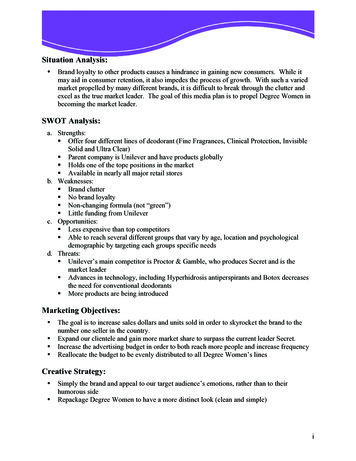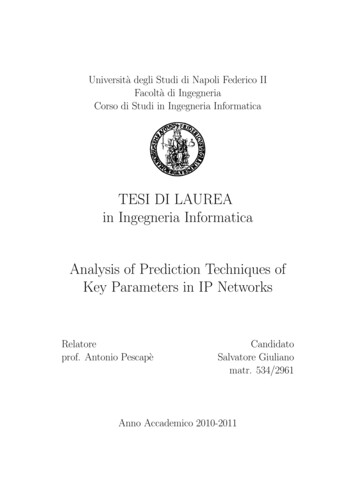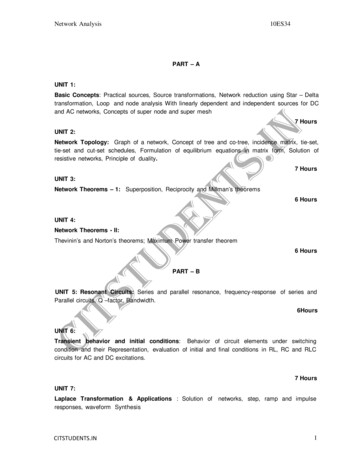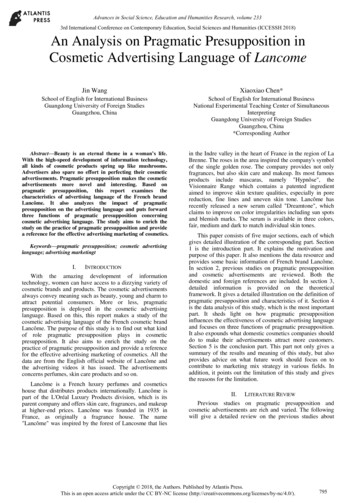
Transcription
Advances in Social Science, Education and Humanities Research, volume 2333rd International Conference on Contemporary Education, Social Sciences and Humanities (ICCESSH 2018)An Analysis on Pragmatic Presupposition inCosmetic Advertising Language of LancomeJin WangXiaoxiao Chen*School of English for International BusinessGuangdong University of Foreign StudiesGuangzhou, ChinaSchool of English for International BusinessNational Experimental Teaching Center of SimultaneousInterpretingGuangdong University of Foreign StudiesGuangzhou, China*Corresponding AuthorAbstract—Beauty is an eternal theme in a woman’s life.With the high-speed development of information technology,all kinds of cosmetic products spring up like mushrooms.Advertisers also spare no effort in perfecting their cosmeticadvertisements. Pragmatic presupposition makes the cosmeticadvertisements more novel and interesting. Based onpragmatic presupposition, this report examines thecharacteristics of advertising language of the French brandLancôme. It also analyzes the impact of pragmaticpresupposition on the advertising language and puts forwardthree functions of pragmatic presupposition concerningcosmetic advertising language. The study aims to enrich thestudy on the practice of pragmatic presupposition and providea reference for the effective advertising marketing of cosmetics.in the Indre valley in the heart of France in the region of LaBrenne. The roses in the area inspired the company's symbolof the single golden rose. The company provides not onlyfragrances, but also skin care and makeup. Its most famousproducts include mascaras, namely "Hypnôse", theVisionnaire Range which contains a patented ingredientaimed to improve skin texture qualities, especially in porereduction, fine lines and uneven skin tone. Lancôme hasrecently released a new serum called "Dreamtone", whichclaims to improve on color irregularities including sun spotsand blemish marks. The serum is available in three colors,fair, medium and dark to match individual skin tones.Keywords—pragmatic presupposition; cosmetic advertisinglanguage; advertising marketingtI.INTRODUCTIONWith the amazing development of informationtechnology, women can have access to a dizzying variety ofcosmetic brands and products. The cosmetic advertisementsalways convey meaning such as beauty, young and charm toattract potential consumers. More or less, pragmaticpresupposition is deployed in the cosmetic advertisinglanguage. Based on this, this report makes a study of thecosmetic advertising language of the French cosmetic brandLancôme. The purpose of this study is to find out what kindof role pragmatic presupposition plays in cosmeticpresupposition. It also aims to enrich the study on thepractice of pragmatic presupposition and provide a referencefor the effective advertising marketing of cosmetics. All thedata are from the English official website of Lancôme andthe advertising videos it has issued. The advertisementsconcerns perfumes, skin care products and so on.Lancôme is a French luxury perfumes and cosmeticshouse that distributes products internationally. Lancôme ispart of the L'Oréal Luxury Products division, which is itsparent company and offers skin care, fragrances, and makeupat higher-end prices. Lancôme was founded in 1935 inFrance, as originally a fragrance house. The name"Lancôme" was inspired by the forest of Lancosme that liesThis paper consists of five major sections, each of whichgives detailed illustration of the corresponding part. Section1 is the introduction part. It explains the motivation andpurpose of this paper. It also mentions the data resource andprovides some basic information of French brand Lancôme.In section 2, previous studies on pragmatic presuppositionand cosmetic advertisements are reviewed. Both thedomestic and foreign references are included. In section 3,detailed information is provided on the theoreticalframework. It gives a detailed illustration on the definition ofpragmatic presupposition and characteristics of it. Section 4is the data analysis of this study, which is the most importantpart. It sheds light on how pragmatic presuppositioninfluences the effectiveness of cosmetic advertising languageand focuses on three functions of pragmatic presupposition.It also expounds what domestic cosmetics companies shoulddo to make their advertisements attract more customers.Section 5 is the conclusion part. This part not only gives asummary of the results and meaning of this study, but alsoprovides advice on what future work should focus on tocontribute to marketing mix strategy in various fields. Inaddition, it points out the limitation of this study and givesthe reasons for the limitation.II.LITERATURE REVIEWPrevious studies on pragmatic presupposition andcosmetic advertisements are rich and varied. The followingwill give a detailed review on the previous studies aboutCopyright 2018, the Authors. Published by Atlantis Press.This is an open access article under the CC BY-NC license 95
Advances in Social Science, Education and Humanities Research, volume 233pragmatic presupposition and cosmetic advertisements. Boththe foreign and domestic studies will be considered.A. Previous Studies on Pragmatic Presupposition from aTheoretical PerspectivePrevious studies on pragmatic presupposition are rich andassorted. Some analyzes the relation between semanticpresupposition and pragmatic presupposition while othersuse pragmatic presupposition to study subjects in differentfields such as advertisement, education and socialphenomena.Kang (2012) makes a detailed study of too in theframework of presupposition. She aims to probe its use as apresupposition trigger bordering in semantics and pragmatics.In doing so, she hopes to solve a great amount of problemsthat are controversial and have no unified solutions now.From her point of view, too is considered as a pragmaticpresupposition trigger in pragmatics. It can express thediscriminative meaning in everyday conversation while alsoplays an essential role in textual organization andinformation flow in discourse.Schlenker (2008) holds that the analysis ofpresupposition projection contributed to a dynamic turn insemantics. He explores an alternative in whichpresupposition projection follows from the combination of afully classical semantics with two pragmatic principles ofmanner. From his perspective, two equivalence theoremsguarantee that principles derive Heim’s results in almost allcases. He gives a flexible analysis of this incremental bias.Lanre-Abass (2010) studies the relation between racismand presupposition. He holds that racism has been describedas a litmus test which reveals other disorders and injusticeswithin a society. From his point of view, racism presupposesthe legitimacy of racial classifications and the metaphysicalreality of races and therefore provides a vital area of scrutinyfor philosophical traditions. He examines racism and its antisocial effects both on the individual and the society at large.Xuan (2015) elaborates an extended notion ofpresupposition in the categorization construed in lexis in ahistorical context on a cognitive basis. She discusses lexicalpresupposition in terms of ostensive inferences in ancientChinese categorization: the functions of the radicals in theirderivatives in Shuowen Jiezi. From her perspective, radicalswork to constitute a ground-figure opposition with the mostsalient and characteristic features resembling statementassertions in sentences. Based on this, she develops a newapproach to the study of pragmatic presupposition.Masia (2016) investigates the processing ofpresupposition in discourse through the Event-related brainpotential technique. She holds that while theoreticallinguistics has largely described as the phenomenon ofpresupposition, there is little empirical investigation, mainlyfrom behavioral studies. She employs the event-relatedpotential technique to search for the brain signature ofpresupposition as opposed to assertion in discourse. Fromthis point, her study is another breakthrough in the study ofpragmatic presupposition.B. Previous Studies on Pragmatic Presupposition Based onPractical ApplicationJust as studies on pragmatic presupposition from atheoretical perspective, studies on pragmatic presuppositionbased on practical application are also fruitful and yield anumber of worthwhile and meaningful discoveries.Wang (2013) studies the presupposition in advertisinglanguage with qualitative analysis. He divides pragmaticpresupposition into five types and finds that pragmaticpresupposition functions prominently. He further explainswhy pragmatic presupposition is adopted by the advertisersand elaborates the use of pragmatic presupposition. Hehoped that the readers could recognize the useful informationof advertisement and enjoy the special kind ofcommunication.Zeng (2012) holds that the production and interpretationof advertisements cannot be separated from both theadvertisers’ and its receivers’ analysis and understanding ofpresupposition. She classified the presuppositions hidden inthe advertisements into four categories according to thespecial characteristics of advertising languages and theprevious research on the presupposition theory. From herperspective, the four types contact and compensate for oneanother and they can be utilized to help people understandthe natural language of advertisements more completely anddeeply.Cong and Chou (2016) make a detailed analysis on pposition and semantic presupposition. From their pointof view, semantic presupposition limits the research scale tothe internal framework of a proposition and a sentence, whilepragmatic presupposition considers the presuppositionconcerning the speakers, beyond the proposition or sentence.Thus, they advocate that the two presuppositions should bestudied on, in that they complete and perfect each other. As aresult, they conclude that it is more practical and dialecticalto study the natural language through these two perspectives.C. Previous Studies on Cosmetic AdvertisementsPrevious studies on cosmetic advertisements focus on thecharacteristics of cosmetic advertisements and translationmethod or strategy of advertisement translation. Thefollowing are some detailed information.Xi (2013) holds that pragmatic presupposition, as acategory based on the prototype theory, has the prototypicalpragmatic presupposition and the non-prototypical pragmaticpresupposition structure. She analyzes the pragmaticpresupposition in advertisement translation in terms ofprototype theory, in order to reveal that the successfultranslations of advertisements result from the wise usage ofprototypic pragmatic presuppositions from the aspect ofcultural background, language habits and social phenomena.Zhang (2008) examines the translation of cosmeticadvertisements. From his point of view, cosmeticadvertisement is an important channel for the promotion ofcosmetics. Based on the examples of world famousinternational brands and the Skopo theory, he makes a796
Advances in Social Science, Education and Humanities Research, volume 233comparison between the feature of Chinese and foreigncosmetic advertisements. He further discusses differenttranslation versions in terms of style and strategy and makesa summary of the pros and cons of the various translationversions.Yan (2011) holds that advertisements have manydistinctive features such as high-speed and broadtransmission. In this case, cosmetic companies attach greatimportance to the language of advertisements, especiallywhen the competition is fierce in the cosmetics industry.Under this circumstance, she analyzes all kinds ofadvertisements in the Fashion magazine, covering productslike fashion clothing, luxuries, skin care products and so on.She also looks into how those advertisements catch the eyesof potential consumers, female consumers in particular.III.THEORETICAL BACKGROUNDPresupposition is one of the most vital concepts in bothpragmatics and philosophy. It was first introduced topragmatics in 1970s and since then it has received wideattention both at home and abroad. This topic in pragmaticsoriginates form the debates about the nature of reference inphilosophy. These debates are the main concern in logicaltheory. They arise from the consideration of how to translatethe referring expressions in natural language into restrictedlogical language. A presupposition is generally known as animplicit assumption about the world or background beliefrelating to an utterance whose truth is taken for granted indiscourse.A. The Definition of Pragmatic PresuppositionGerman philosopher Gottlob Frege, the architect ofmodern logic was the first one to deal with issues concerningthe referring expressions in natural language. Strawson andFrege use semantic concepts such as truth and false value theanalyze presuppositions. But the presuppositions theywrestle with are mainly concerned with statement, notsentence. Statements can be judged in communication, butnot all sentences can be analyzed through truth value. As aresult, presupposition develops into two major categories:semantic presupposition and pragmatic presupposition.Pragmatic presuppositions are presuppositions that areanalyzed from a pragmatic perspective rather than a semanticperspective. The definition of pragmatic presupposition isvaried, which means that its definition is not universallyacknowledged. The following are some definitions given bysome famous scholars.Keenan (1971) is the first linguist who put forward theconcept of pragmatic presupposition. He thinks it can be bestdescribed as a relation between a speaker and theappropriateness of a sentence in a context. Stalnaker (1991)joined in in 1991 and offered his own opinion. From hisperspective, pragmatic presupposition is made by personsrather than sentences, propositions or speech act. Yule (1996)holds that pragmatic presupposition is something the speakerassumes to be the case prior to making an utterance. Pecci(2000) defines it as the speaker’s assumption and inferencesabout what is assumed to be true in the utterance rather thandirectly asserted to be true.All of these definitions focus on two important conceptsin particular: appropriateness and common ground. It meansthat if an utterance A pragmatically presupposes aproposition B, A has to be appropriate and B is mutuallyknown by all the participants involved in a conversation.B. The Characteristics of Pragmatic PresuppositionAs the definition of pragmatic presupposition is variedand assorted, so are the characteristics of pragmaticpresupposition. During the development of pragmaticpresupposition, more and more features and characteristicsare discovered and put forward by numerous scholars andlinguists. Levinson found out two basic properties ofpresupposition, namely, defeasibility and the projectionproblem. Later, some believe that the most importantproperties of pragmatic presupposition are appropriatenessand common ground, while others believe that it also possessother properties such as subjectiveness and unidirectionality.However, this paper only focuses on the two most commonlyreceived characteristics: appropriateness and commonground.Appropriateness concerns the close relationship betweenpresupposition and the context. Presuppositions areappropriate only if the presupposition indicated by thepresupposition trigger is true. If the presupposition indicatedis not true, the sentence in fact has no meaning at all. Forexample, if a man tells you John was shopping with his son,but you know that John is still a teenager, the sentence ismeaningless and the presupposition is not appropriate. It ispossible that the man who tells you this mistakes the boywith John as John’s son, possibly because John really has amature face.Common ground is also an indispensible characteristic ofpresuppositions. For a presupposition indicated bypresupposition triggers to be meaningful, the presuppositionshould be mutually known by the participants involved in theconversation. Mutual knowledge is very important. Thebackground information should be understood by both thespeaker and the hearer, in this case, the conversation cancontinue. Here is an example: A: Can you wait for John inthe cinema? If the hearer has no idea who John is, thisconversation is dead already. It is possibly the A assumesthat the hearer knows John but she is too confidents abouther own assumption.IV.METHODOLOGYAll the data used in this paper is either from the Englishofficial website of Lancôme or from the advertisements or advideos online. The advertisements cover cosmetic productssuch as perfumes, essence and moisturizer. Five typical onesare chosen to detail the analysis. The followings are the fiveadvertisements: The fragrance for treasured moments; Themore I live, the younger I am; Your Skin Care Destination;You are unique, you are magnifique; I'm happier aboutmyself than I've ever been. Confidence and energy make awoman stand out.797
Advances in Social Science, Education and Humanities Research, volume 233All the advertisements will be analyzed generally in threesteps. Firstly, the underlying meaning of the advertisementtogether with the presupposition it concerns with will bedetailed. Secondly, consumers’ expectation and thoughtsabout the advertised product will be examined. Finally, thecomparison between the aforementioned two will lead towhat kind of function and effect of the advertisement has.These advertisements are examined in three categoriesaccording to the functions of presuppositions in the cosmeticadvertisements.The study will take into consideration questions like: Dopresuppositions in the cosmetic advertisements influenceconsumers’ decisions? How do they contribute to thepurchasing behavior of potential consumers? What are thefunctions of presupposition in cosmetic advertisements?Detailed analysis will be given in each segmented part.V.RESULTS AND DISCUSSIONA. Pragmatic Presupposition Makes CosmeticAdvertisements More ConciseThe main purpose of advertisements is to convey theinformation about the product and the functions of theproduct to the potential consumers. For cosmeticadvertisements, the information is all about the magicfeatures of the product. There is a great amount ofinformation that the advertisers want to deliver, but it isimpossible to include all of them. In this case, someinformation has to be hidden in one or two sentences. That ishow presupposition works in the cosmetic advertisements,making them more concise. A sentence in an advertisementcan presuppose rich information about the product.Example 1: The fragrance for treasured moments.This is the advertisement for one best-selling perfume ofLancôme—the Tresor series. Though short and concise, thissentence contains important information for the potentialcustomers. It is not a stretch to find out that theadvertisement presupposes that every woman has treasuredmoments in her life. For a girl first in love, a treasuredmoment may be the first date with the boy she has a crush on;for a capable white-collar, it may be a very importantmeeting with her seniors; for a middle-aged woman, it maybe a reunion with her long-time-no-see friends or collegeclassmates. In treasured moments, everyone wants to bringthe best out of them and leave a wonderful impression onothers. Then what do they need for such treasured moments?It is the fragrance. The fragrance refers to the perfume.Everything the advertisement wants to tell the customers isclear now: the perfume Tresor is suitable for all kinds oftreasured moments in your life. In this way, theadvertisement is concise but not plain or inane.B. Pragmatic Presupposition Makes CosmeticAdvertisements More PersuasiveEvery advertisement aims to persuade consumers to buythe advertised products. Thus, advertisers spare no effort inmaking their advertisements persuasive. So
An Analysis on Pragmatic Presupposition in Cosmetic Advertising Language of Lancome. Jin Wang . . a reference for the effective advertising marketing of cosmetics. . the internal
